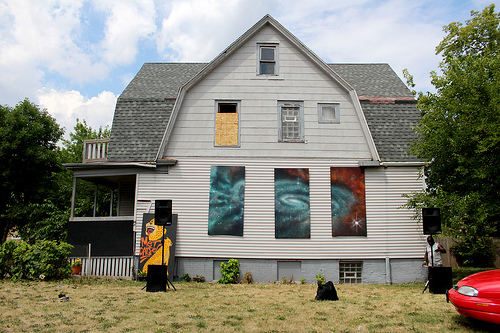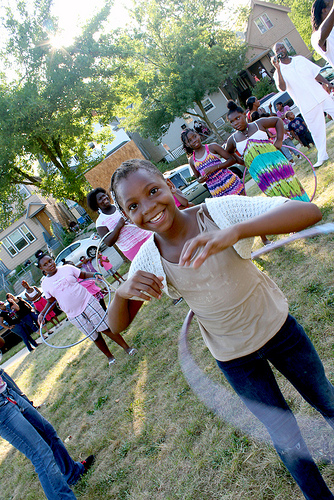 Metcalfe Park
Metcalfe Park
Placemaking Principle #3: You can't do it alone.

Vacant lot that was temporarily transformed into a community gathering place last summer. Photo credit: Erin Dorbin
Like many communities across the country, Milwaukee’s Metcalfe Park was hit hard by the recent economic crisis. Suffering from foreclosures, violent and petty crime, and a highly transient population, the odds seemed to be stacked against residents, leaving them feeling alone and isolated – afraid to be outside getting to know their neighbors.
It wasn’t that community members didn’t have ideas as to what could be done to improve the neighborhood, but being afraid to be outside meant they hadn’t had the opportunity to talk to each other and realize they shared many of the same concerns and hopes for transformation. But last summer residents began to learn how much of an impact they could have once they started a conversation.
Through her work with Safe and Sound, a local community-based organization, Erin Dorbin noticed how alone many residents felt in their frustrations, and together with those residents, organized a cleanup day in Metcalfe Park as a first step. There, she met volunteers and local residents Danell Cross and Angela Pruitt. “I don’t know my neighbors, I’m in this on my own,” Pruitt told Dorbin as she reflected on her feeling of isolation and seeming lack of ability to make positive change in her neighborhood. But Cross and Pruitt quickly realized that they shared common goals for their community and wanted to take action to reduce crime and make the neighborhood a healthy and safe place for their children and grandchildren.
Working with Dorbin, Pruitt and Cross explored the question, “what if we do have a say in what goes on here?” The three brainstormed ideas for new ways that neighbors could come out into the community and get to know each other and a movie in the park topped the list. A vacant lot on a nearby corner was the perfect location. The idea raised some concern with skeptical residents due to a number of shootings just a few blocks away from the lot, but the larger goal of uniting residents prevailed.
Organizers put fliers up throughout the neighborhood to promote the event and even a downpour just an hour before didn’t deter residents. As soon as the rain stopped, “you could see people walking down the street in small crowds,” all heading toward the event, Pruitt recalls. Approximately 200 people were in attendance.

Residents help set up for the event. Photo Credit: Erin Drobin
Local businesses and other community organizations were eager to participate. The event offered food and raffles. Business owners spent time getting to know attendees. A barber came out on his day off to give free haircuts and a resident chef prepared food. A news team from Fox Channel 6 came out and spent 2 hours at the event. In a neighborhood lacking much summer programming for youth, fun activities like hula-hoop competitions and face painting stations were set up for the kids. Head Start and Goodwill set up resource tables as did other community health and housing organizations. Perhaps surprisingly, the resources were more popular than the food at the event.

Hula-hoop contests were organized for the kids. Photo credit: Erin Dorbin
In a neighborhood with a reputation for crime, some were concerned about hosting an outdoor evening event. There was very little police presence, and none was required – the police dropped in early and came back after dark. “The presence of everyone there, engaging in something positive prevented any opportunity for negative or violent activity,” Dorbin recalls. The group credits some of the positive energy of the night to advanced planning. Fliers posted reminded attendees to bring a positive attitude and every person in attendance was greeted as they entered. As the night came to a close, attendees were talking about other vacant lots where similar events could be held, but more importantly, residents were starting to feel like they could be a part of changing perceptions of the neighborhood.
This project relates to Placemaking Principle 3 – you can’t do it alone. People are attracted to dense, urban environments because of the opportunities they provide for social interaction. As described in a recent article in Making Cities Livable, individuals who interact frequently with one another have an increased sense of belonging. This social capital tends to result in fewer negative health outcomes for those who have it than those who don’t. Feelings of isolation often result for those living in neighborhoods where concerns for personal safety prohibit them from engaging with their community.
Once suffering from feelings of isolation, concerned residents of Metcalfe Park have formally organized into the Metcalfe Park Community Action Team (MPCAT). Through the movie in the park event, they proved to themselves that they could make a change in their neighborhood by working together and involving other concerned residents. “This is about fighting through adversity, getting to know one another, and understanding that we can’t stay behind locked doors. We have to get out and do the work ourselves,” says Pruitt. MPCAT’s plans for this year include putting together neighborhood associations for homeowners and renters, planning 4 movie nights in various vacant lots this summer and turning the lot at 32nd and Garfield into a playground for kids. The neighborhood is seeing more unification than ever before.





